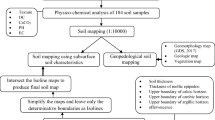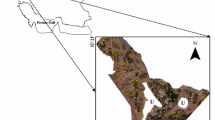Abstract—
A soil map provides information on soil spatial distribution. Such information is essential for effective use of soil resources for crop production, land evaluation, spatial planning, environmental control, and for other similar purposes. In this study, a digital soil map for a semiarid region of Afghanistan was developed. This map contains soil taxonomic information up to the subgroup level, which is the first such attempt in Afghanistan. A total of 114 soil samples were collected in and around the Khost Province through an intensive soil survey. The collected samples were classified into 14 subgroups of soils, following the USDA soil classification system. A soil land inference model (SoLIM) was applied for mapping the recognized 14 soil subgroups digitally, via an expert knowledge-based fuzzy soil inference scheme, with surface topography and other spatial data as inputs. The overall accuracies from the error matrix and Kappa statistics were 0.74 and 0.71, respectively. This map was also compared with the currently used soil map. A general agreement between the two maps was found in the spatial distribution of soil classes, at the great group level. However, the newly developed map contains more detailed information on soils, which might be useful for the advanced use of soil information, for example, to better determine the crop type for cultivation by considering the detailed soil properties. Throughout this study, 14 different recognized classes of soil subgroups were digitally mapped in the study area.





Similar content being viewed by others
REFERENCES
A. Jafari, H. Khademi, P.A. Finke, J. Van de Wauw, and S. Ayoubi, “Spatial prediction of soil great groups by boosted regression trees using a limited point dataset in an arid region, southeastern Iran,” Geoderma 232–234, 148–163 (2014). https://doi.org/10.1016/j.geoderma.2014.04.029
A. Jafari, P. A. Finke, J. Vande Wauw, S. Ayoubi, and H. Khademi, “Spatial prediction of USDA—great soil groups in the arid Zarand region, Iran: comparing logistic regression approaches to predict diagnostic horizons and soil types,” Eur. J. Soil Sci. 63 (2), 284–298 (2012). https://doi.org/10.1111/j.1365-2389.2012.01425.x
A. Jafari, S. Ayoubi, H. Khademi, P. A. Finke, and N. Toomanian, “Selection of a taxonomic level for soil mapping using diversity and map purity indices: a case study from an Iranian arid region,” Geomorphology 201, 86–97 (2013). https://doi.org/10.1016/j.geomorph.2013.06.010
A. C. Hildreth, Afghan Soils in Relation to Agricultural Production (Cheyenne, WY, 1957).
A. X. Zhu and L. E. Band, “A knowledge-based approach to data integration for soil mapping,” Can. J. Remote Sens. 20 (4), 408–418 (1994). https://doi.org/10.1080/07038992.1994.10874583
A. X. Zhu, “A similarity model for representing soil spatial information,” Geoderma 77 (2–4), 217–242 (1997). https://doi.org/10.1016/S0016-7061(97)00023-2
A. X. Zhu, “Mapping soil landscape as spatial continua: the neural network approach,” Water Resour. Res. 36 (3), 663–677 (2000). https://doi.org/10.1029/1999WR900315
A. X. Zhu, B. Hudson, J. Burt, K. Lubich, and D. Simonson, “Soil mapping using GIS, expert knowledge, and fuzzy logic,” Soil Sci. Soc. Am. J. 65 (5), 1463–1472 (2001). https://doi.org/10.2136/sssaj2001.6551463x
A. X. Zhu, L. Band, R. Vertessy, and B. Dutton, “Derivation of soil properties using a soil land inference model (SoLIM),” Soil Sci. Soc. Am. J. 61 (2), 523–533 (1997). https://doi.org/10.2136/sssaj1997.03615995006100020022x
A. X. Zhu, L. E. Band, B. Dutton, and T. J. Nimlos, “Automated soil inference under fuzzy logic,” Ecol. Model. 90 (2), 123–145 (1996). https://doi.org/10.1016/03043800(95)00161-1
B. Adams and S. S. D. Foster, “Land-surface zoning for groundwater protection,” Water Environ. J. 6 (4), 312–319 (1992). https://doi.org/10.1111/j.17476593.1992.tb00755.x
B. Boonsompopphan, T. Vearasilp, R. S. Yost, and T. Attanandana, “Field identification of soil series: indexing and retrieving soil information while sharing experience and knowledge,” Soil Sci. 173 (10), 736–744 (2008). https://doi.org/10.1097/SS.0b013e31818939cf
B. Fu, L. Chen, K. Ma, H. Zhou, and J. Wang, “The relationships between land use and soil conditions in the hilly area of the loess plateau in northern Shaanxi, China,” Catena 39 (1), 69–78 (2000). https://doi.org/10.1016/S0341-8162(99)00084-3
C. F. Pain, M. A. Abdelfattah, S. A. Shahid, and C. Ditzler, “Soil-landform relationships in the arid northern United Arab Emirates,” in Geopedology: An Integration of Geomorphology and Pedology for Soil and Landscape Studies (Springer-Verlag, New York, 2016), pp. 211–225. https://doi.org/10.1007/978-3-319-19159-1_12
D. J. Bedendo, G. A. Schulz, G. F. Olmedo, and M. E. Angelini, “Updating a physiography-based soil map using digital soil mapping techniques,” in Geopedology: An Integration of Geomorphology and Pedology for Soil and Landscape Studies (Springer-Verlag, New York, 2016), pp. 285–303. https://doi.org/10.1007/978-3-319-19159-1_18
D. J. Pennock, B. J. Zebarth, and E. De Jong, “Landform classification and soil distribution in hummocky terrain, Saskatchewan, Canada,” Geoderma 40 (3–4), 297–315 (1987). https://doi.org/10.1016/0016-7061(87)90040-1
D. L. Corwin, P. J. Vaughan, and K. Loague, “Modeling nonpoint source pollutants in the vadose zone with GIS,” Environ. Sci. Technol. 31 (8), 2157–2175 (1997). https://doi.org/10.1021/es960796v
D. N. Kozlov and M. V. Konyushkova, “State of the art and prospects of digital soil mapping: the results of the third global workshop (Logan, USA, 2008),” Eurasian Soil Sci. 42, 699–702 (2009). https://doi.org/10.1134/S1064229309060167
E. Stehfest, D. van Vuuren, T. Kram, et al., Integrated Assessment of Global Environmental Change with IMAG-E 3.0: Model Description and Policy Applications (PBL Netherlands Environmental Assessment Agency, Hague, 2014).
E. Wali, A. Datta, R. P. Shrestha, and S. Shrestha, “Development of a land suitability model for saffron (Crocus sativus L.) cultivation in Khost Province of Afghanistan using GIS and AHP techniques,” Arch. Agron. Soil Sci. 62 (7), 921–934 (2016). https://doi.org/10.1080/03650340.2015.1101519
F. Abbaszadeh Afshar, S. Ayoubi, and A. Jafari, “The extrapolation of soil great groups using multinomial logistic regression at regional scale in arid regions of Iran,” Geoderma 315, 36–48 (2018). https://doi.org/10.1016/j.geoderma.2017.11.030
F. R. Troeh and L. M. Thompson, Soils and Soil Fertility, 6th ed. (Wiley, New York, 2005).
Calcareous Soils: Regional Seminar on Reclamation and Management of Calcareous Soils (UN Food and Agriculture Organization, Rome, 1973).
H. Eswaran, R. Ahrens, T. J. Rice, and B. A. Stewart, Soil Classification: A Global Desk Reference (CRC Press, Boca Raton, FL, 2002). https://doi.org/10.1201/9781420040364
H. Jenny, The Soil Resource: Origin and Behavior (Springer-Verlag, New York, 1980). https://doi.org/10.1007/978-1-4612-6112-4
I. B. Campbell and G. G. C. Claridge, Antarctica: Soils, Weathering Processes and Environment (Elsevier, Amsterdam, 1987).
J. Gilluly, A. C. Waters and A. O. Woodford, Principles of Geology (W.H. Freeman, San Francisco, 1959).
Geopedology: An Integration of Geomorphology and Pedology for Soil and Landscape Studies, Ed. by J. A. Zinck, G. Metternicht, G. Bocco, and H. F. Del Valle (Springer-Verlag, New York, 2016). https://doi.org/10.1007/978-3-319-19159-1
J. F. Shroder, Natural Resources in Afghanistan: Geographic and Geologic Perspectives on Centuries of Conflict (Elsevier, Amsterdam, 2014).
J. Hans, Factors of Soil Formation: A System of Quantitative Pedology (McGraw-Hill, New York, 1994).
K. D. Sharma, H. P. Singh, and O. P. Pareek, “Rainwater infiltration into a bare loamy sand,” Hydrol. Sci. J. 28 (3), 417–424 (1983). https://doi.org/10.1080/02626668309491980
L. Deharveng, “Soil Collembola diversity, endemism, and reforestation: a case study in the Pyrenees (France),” Conserv. Biol. 10 (1), 74–84 (1996). https://doi.org/10.1046/j.15231739.1996.10010074.x
M. Zeraatpisheh, S. Ayoubi, A. Jafari, and P. Finke, “Comparing the efficiency of digital and conventional soil mapping to predict soil types in a semiarid region in Iran,” Geomorphology 285, 186–204 (2017). https://doi.org/10.1016/j.geomorph.2017.02.015
M. A. Abdelfattah and S. A. Shahid, “A comparative characterization and classification of soils in Abu Dhabi coastal area in relation to arid and semiarid conditions using USDA and FAO soil classification systems,” Arid Land Res. Manage. 21 (3), 245–271 (2007). https://doi.org/10.1080/15324980701426314
M. P. Smith, A. X. Zhu, J. E. Burt, and C. Stiles, “The effects of DEM resolution and neighborhood size on digital soil survey,” Geoderma 137 (1), 58–69 (2006). https://doi.org/10.1016/j.geoderma.2006.07.002
M. Z. Salem and F. D. Hole, “Soil geography and factors of soil formation in Afghanistan,” Soil Sci. 107 (4), 289–295 (1969). https://doi.org/10.1097/00010694-196904000-00009
P. Borrelli, P. Panagos, C. Ballabio, E. Lugato, M. Weynants, and L. Montanarella, “Towards a pan-European assessment of land susceptibility to wind erosion,” Land Degrad. Dev. 27 (4), 1093–1105 (2014). https://doi.org/10.1002/ldr.2318
P. A. Burrough, “Opportunities and limitations of GIS-based modeling of solute transport at the regional scale,” in Applications of GIS to the Modeling of Non-Point Source Pollutants in the Vadose Zone, SSSA Special Publications vol. 48 (Soil Science Society of America, Madison, WI, 1996), pp. 19–38. https://doi.org/10.2136/sssaspecpub48.c2
P. Panagos, A. Imeson, et al., “Soil conservation in Europe: wish or reality?” Land Degrad. Dev. 27 (6), 1547–1551 (2016). https://doi.org/10.1002/ldr.2538
P. Krasilnikov, V. Sidorova, and I. Dubrovina, “Soil-geographical regionalization as a basis for digital soil mapping: Karelia case study,” Eurasian Soil Sci. 43, 1422–1429 (2010). https://doi.org/10.1134/S1064229310130028
R. Favre and G. M. Kamal, Watershed Atlas of Afghanistan (Ministry of Irrigation, Water Resources and Environment, Kabul, 2004).
R. John, J. W. Dalling, K. E. Harms, et al., “Soil nutrients influence spatial distributions of tropical tree species,” Proc. Natl. Acad. Sci. U.S.A. 104 (3), 864–869 (2007). https://doi.org/10.1073/pnas.0604666104
R. Taghizadeh-Mehrjardi, F. Sarmadian, B. Minasny, J. Triantafilis, and M. Omid, “Digital mapping of soil classes using decision tree and auxiliary data in the Ardakan region, Iran,” Arid Land Res. Manage. 28 (2), 147–168 (2014). https://doi.org/10.1080/15324982.2013.828801
R. G. Congalton, “A review of assessing the accuracy of classifications of remotely sensed data,” Remote Sens. Environ. 37 (1), 35–46 (1991). https://doi.org/10.1016/00344257(91)90048-B
Soil Survey Staff, Soil Taxonomy: A Basic System of Soil Classification for Making and Interpreting Soil Surveys (US Department of Agriculture, Washington, DC, 1999).
S. Tajik, S. Ayoubi, and F. Nourbakhsh, “Prediction of soil enzymes activity by digital terrain analysis: comparing artificial neural network and multiple linear regression models,” Environ. Eng. Sci. 29 (8), 798–806 (2012). https://doi.org/10.1089/ees.2011.0313
S. Z. Hashami, PhD Thesis (Purdue University, West Lafayette, IN 2011).
Y. M. M. Bishop, S. E. Fienberg, and P. W. Holland, Discrete Multivariate Analysis: Theory and Practice (Springer-Verlag, New York, 1974).
Z. Zolfaghari, S. Ayoubi, and M. R. Mosaddeghi, “Spatial variability of some soil shrinkage indices in hilly calcareous region of western Iran,” Soil Tillage Res. 150, 180–191 (2015). https://doi.org/10.1016/j.still.2015.01.016
ACKNOWLEDGMENTS
The authors acknowledge the financial assistance provided by the World Bank under the Higher Education Development Program (HEDP). The authors also thank the Department of Statistics and GIS, Ministry of Agriculture, Irrigation, and Livestock (MAIL), Afghanistan, for providing secondary data.
Funding
This research was funded by the World Bank under the Higher Education Development Program (HEDP), grant number P146184.
Author information
Authors and Affiliations
Corresponding author
Ethics declarations
The authors declare that they have no conflict of interest.
Rights and permissions
About this article
Cite this article
Emal Wali, Tasumi, M. & Shinohara, Y. Classification and Digital Mapping of Soils in a Semiarid Region of Afghanistan. Eurasian Soil Sc. 54, 38–48 (2021). https://doi.org/10.1134/S1064229321010142
Received:
Revised:
Accepted:
Published:
Issue Date:
DOI: https://doi.org/10.1134/S1064229321010142




